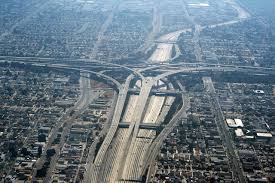Physical Address
304 North Cardinal St.
Dorchester Center, MA 02124
Physical Address
304 North Cardinal St.
Dorchester Center, MA 02124

Suburbs have been around for as long as there have been urbs – cities, that is – a fact Robert Bruegmann reminds us of in his excellent book Sprawl. And as sociologist Max Weber in The City and historian Henri Pirenne in Medieval Cities remind us, it’s often in the younger, freer suburbs rather than the older, more-conservative central city where entrepreneurial energy is unleashed.
The difference today perhaps is that the epithet “sprawl” has been attached to this sort of outward, penumbral development, which, especially in the United States, has taken place very rapidly since World War II. Stripping it of its negative connotations, Bruegmann defines sprawl as “low density, scattered, urban development without systematic large-scale or regional public land-use planning.”
A Sprawling Debate
There has been a lot of Internet chatter lately about what libertarians ought to think about urban sprawl and its causes, including pieces by Kevin Carson, Austin Bramwell, Randal O’Toole, and Matthew Yglesias. The title of Ben Adler’s post basically sums it up: “If You Love the Free Market, You Should Hate Mandated Suburban Sprawl.”
All seems to be centered on O’Toole’s recent comments on John Stossel’s program on Fox Business, which evidently defended urban sprawl against advocates of so-called “Smart Growth,” government policies intended to combat sprawl and its alleged bad consequences. I have not yet seen the show myself, so I’m really just responding here to the interesting reactions it has provoked. (I will perhaps explore the issue of whether sprawl is a good thing or a bad thing in another column.)
On the one side are those, such as O’Toole, who hold that suburban sprawl is chiefly a free-market phenomenon and therefore an expression of consumer demand, and on the other are those, such as Yglesias and myself, who look at the phenomenon of sprawl as greatly abetted by government intervention.
Factors Other than Zoning
The particular bone of contention seems to be whether zoning ordinances and regulations that mandate large areas for parking and other land uses not driven by market demand have been an important factor in promoting low-density development. Before addressing that issue, however, I would like to first say that I’m puzzled over how this particular debate has been framed.
The exchanges focus mainly on zoning rather than other interventions that have been identified over the years as factors that abet sprawl. These include federal subsidies to construct the 46,876-mile-long interstate highway system and intra-urban freeway systems, both of which have made living in the less-expensive fringes of cities cheaper for urban commuters — not to mention federal subsidies for the construction of water mains, sewers, telecommunication lines, and, as we all should be well aware of today, direct and indirect subsidies to single-family home ownership via Fannie Mae, Freddie Mac, and a slew of federal policies intended to promote single-family home ownership, dating back to the Great Depression, including the income-tax deduction for mortgage interest.
(The classic reference for this is Kenneth T. Jackson’s Crabgrass Frontier, although Bruegmann questions whether they have had the impact Jackson and others attribute to them.)
Whether, in particular, zoning ordinances that mandate minimum parking-space requirements are a major contributor to sprawl is, I think, an empirical question. That is, such ordinances wouldn’t make parking free, but merely increase the cost to the builder of constructing a given square-footage of livable space; while the homebuyer, at the margin, will either pay more for parking plus a given amount of livable space, or pay the same amount for parking with less livable space. Whether that means more total area will be developed, and therefore contribute to sprawl, depends on what the relative demands actually are.
The Demand Curve for Sprawl
There are many factors responsible for sprawl, perhaps the strongest of which, as Bruegmann points out, are the aspirations of ordinary people, combined with an unprecedented rise in per capita income during the twentieth century owing to the wealth-generating power of mostly free markets.
But the bottom line is that the law of demand still holds – other things equal, the cheaper you make something the more of it people will want to buy, and that includes low-density development. You’ll get more of that, too, if those direct and indirect subsidies make it cheaper for people to get it. Government intervention has done just that, and it’s hard to understand how you can argue, whether you’re a proponent or (especially) an opponent of Smart Growth, that the free market alone is responsible for the amount of sprawl that we actually have.
This doesn’t mean, of course, that Smart Growth regulations are the place to begin. Instead, if you think sprawl is a bad thing, it would seem logical to first remove the vast array of interventions that over the decades have pushed it along.
On this, I would have thought all market urbanists could agree.

Sandy Ikeda is a professor of economics at Purchase College, SUNY, and the author of The Dynamics of the Mixed Economy: Toward a Theory of Interventionism. He is a member of the FEE Faculty Network.
This article was originally published on FEE.org. Read the original article.
[…] American Cities Are Largely Defined by Sprawl, But It’s Got a Bad Demand Curve (Market Urbanism) […]
O’Toole is not a genuine market urbanist. He’s known for dishonest misuse of statistics (cherry-picking, etc.) and he attacks passenger rail whereever it is and under all circumstances. He’s a paid-for hack, and he’s specifically paid for by the oil industry, which makes most of their money from gasoline, which tells you what’s going on there.